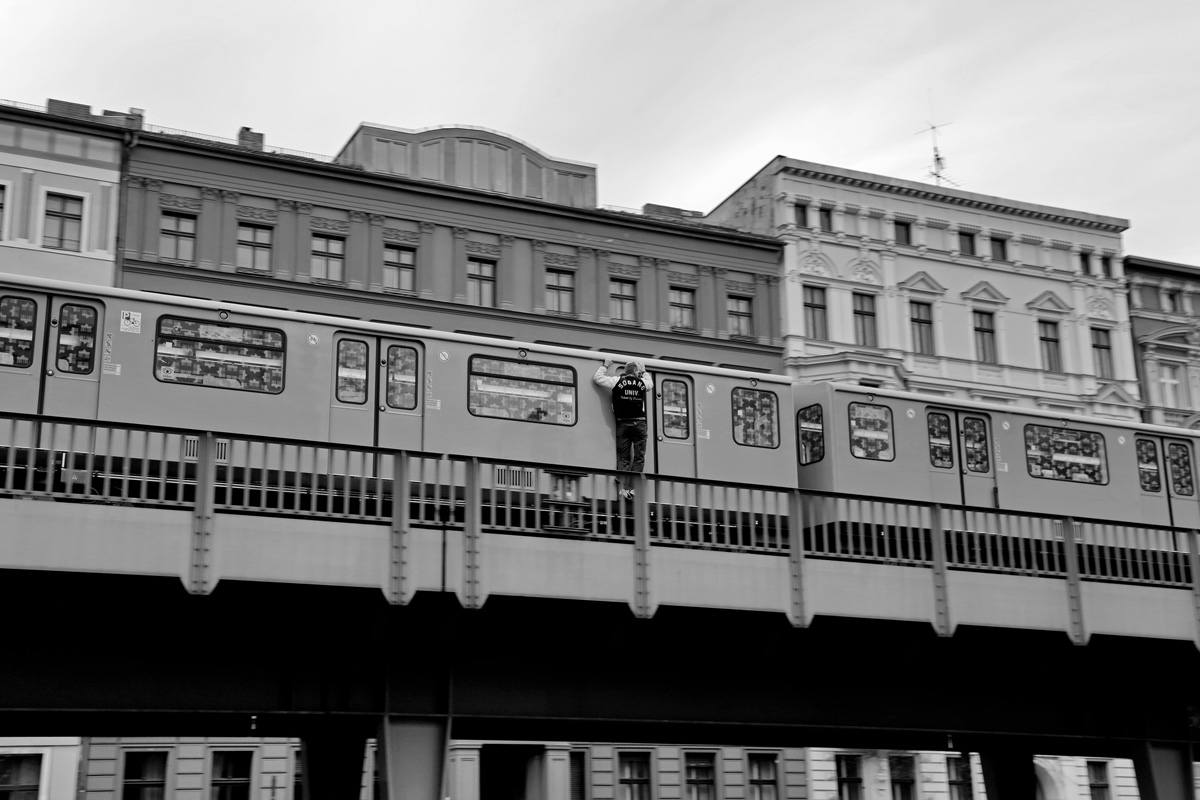
Thomas von Wittich – Cold Steel
Representing one of the brightest young hopes in the world of street art photography, Thomas von Wittich is a German photographer primarily dedicated to documenting the birth and life of urban art pieces in Berlin, following in the steps that were taken by the contemporary urban interventionists as they were painting these works. Emphasizing aspects of street art like legalism and uncontrollability, von Wittich transforms such contexts into his photographies, simultaneously making sure that the pieces can never be truly lost despite the ever-present danger of being painted over and effectively destroyed. Although this young man is definitely paying stylistic tribute to street art photography pioneers like Martha Cooper, Thomas von Wittich has proven time and time again that his images have a certain daring feel to them that really makes them stand out from the rest of the works in this particular field.
Besides focusing on the world of urban art, von Wittich also puts a lot of effort in presenting the entire street subculture through his works, effectively holding his finger to the pulse of the pavement. Thomas is a man of a turbulent past that is not really a common background for most of his fellow photographers and that part of his life helped shape his visual vocabulary of black and white imagery. In his Curriculum Vitae you can find many projects that are not necessarily directly or indirectly connected to urban art – Thomas took numerous images of portraits, traditional street photography and music stars. However, his street art photography is what helped him place his name on the map and provided him with an opportunity to make photos out of things he loves and supports to his core. Thomas von Wittich was himself an urban artist in his time but eventually decided that he is more suitable and comfortable behind the camera than in front of its lens. And as the world waits to see what will Thomas’s Berlin Kidz exhibition present them with, we bring you an interview with the young photographer himself.
A Restless Past That Brought Thomas von Wittich Where He Is
Open Walls: Reasonably, a person’s background has an enormous influence on everything he does in the future. How much of an impact did your turbulent past have on your photographs?
Thomas: I think it’s my turbulent past which led me to a turbulent or lets better say entertaining present which in fact has a huge impact on my photography. I feel comfortable in situations other people wouldn’t and I might find something beautiful or fun where other people would be embarrassed. I like chaos and am very afraid of boredom and normality.
Open Walls: Your transition from a street artist to a photographer is an odd one, especially as you seem to be quite passionate about graffiti. How did this come to be and do you miss creating street art?
Thomas: I wouldn’t go so far and call what I was doing (street) art. I started to paint graffiti in the middle of the 90s and kept on doing that for like ten years or so. It was more a hobby than a profession without any ambitions to create art and it was superfun but more or less everything I painted was looking like shit. As soon as I started to work as a photographer I just couldn’t afford anymore to have all this stress with the police coming to raid my place with taking my computer and all my stuff because I was needing my equipment for my job.
But still, for the 3 or 4 years I was shooting musicians, I never lost any interest in graffiti. I was just not seeing that as a possibility for my photography. So I shot hundreds of rap artists which was nice in the beginning. Imagine being 20 years old and shooting all your favorite musicians, but it’s turned out quite fast to not be fulfilling at all as the magazines I was working for were not really looking for quality. It was just important that you could recognize the artist on the photo, nobody was too much caring about the rest. I got tired of that pretty fast and I was looking for other topics. I just moved to Berlin and became friends with Alias so I decided to accompany him some nights with my camera taking photos of him pasting in the streets. From that point on, I was shooting less and less music; just if I was really interested in the Artist by myself and kept on going shooting more and more street artists. I think if I would have a normal 9 to 17h job in an office or something like that, I would miss going out at night but not for the fact of painting but all those fun stories which happen next to it and meeting all kind of crazy people. And this I still have through my job.
Open Walls: Do you still keep your original camera, the Leica R4? Does it still work and do you still use it?
Thomas: A camera like this is built to last, so yes, it still works. I still have it but sadly, I don’t shoot analog anymore at all. I don’t really see the point for it anymore. All those papers and chemicals or films I was using when I was shooting analog are not produced anymore. I know that there is still people working like this and getting great results but for me it’s just not practical anymore since 7 years or so. I would like to go back to that one day with another project but, for now, I’m more looking to maybe try a digital Leica camera.
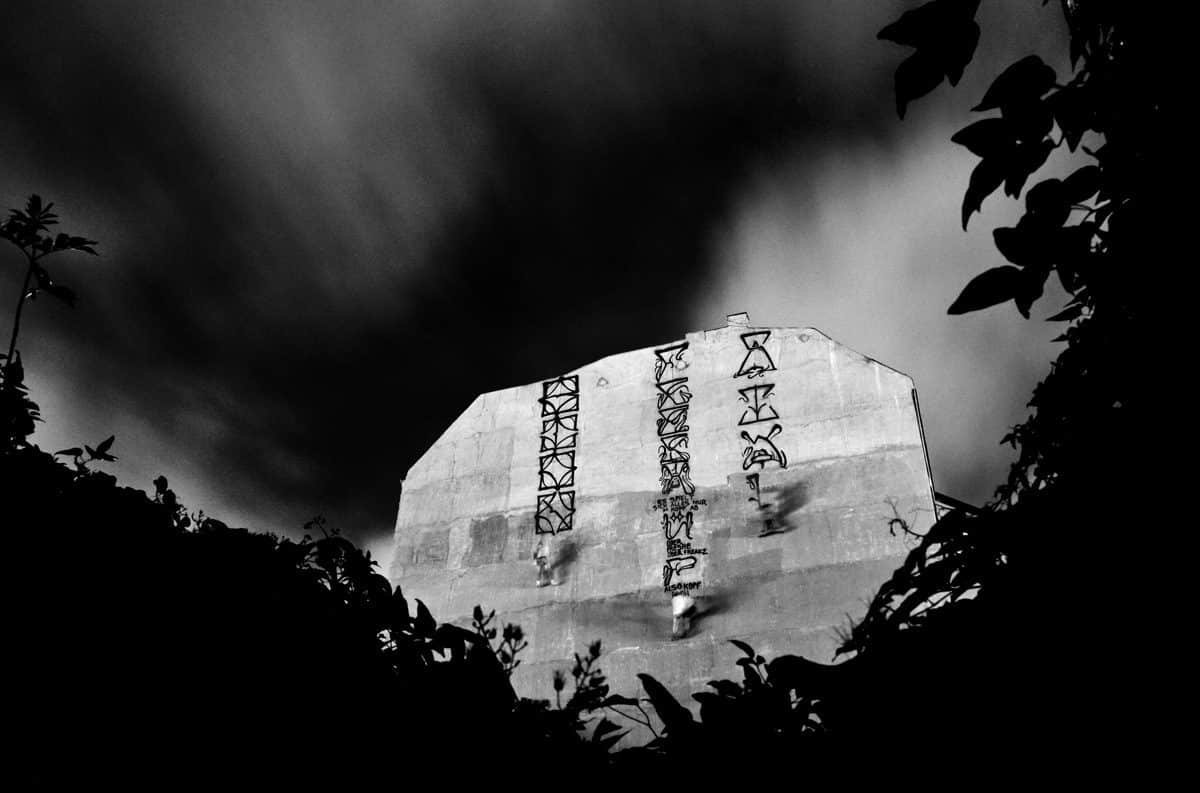
Thomas von Wittich – Keep Off the Lawn
Wittich’s Black and White Street Style
Open Walls: In a time when modern cameras have advanced to an incredible level, you choose to make your photos almost exclusively in a black and white style. What is the reason behind such a decision?
Thomas: That’s how I learned and this is what I like in photography. From 50 of my favorite photographers, maybe 5 are working in color. When I started as an intern from Jeffrey Delannoy I spent the first days just watching photo books from Anton Corbijn, Dennis Stock and Peter Lindbergh. My whole internship and the following assistance I was shooting in b/w and spent countless nights in the darkroom developing my films and printing photos. the very few times I printed in color, I most of the time just used the complete darkness which is necessary in a color darkroom to sleep on the ground under a table. But working in b/w doesn’t mean that I’m not using the advantages from modern cameras. I am very much appreciating the speed of my camera and that I can shoot with high ISO without losing too much quality. And just because you have thousand of options, it doesn’t necessary mean that you have to use all of them, especially when it comes to flashlights and Photoshop. I don’t understand people looking for perfection and 80% of what I see in fashion or beauty photography looks just ridiculous to me.
Open Walls: You obviously focus a lot of attention on the art and culture of the street. Is this simply because you are familiar with this world or is there something else behind such commitment?
Thomas: You can call that passion. I’m not so familiar with this environment by accident. I can still remember the time I was 11 years old listening to a conversation from my parents heavy complaining about some random tags in the streets while for me it was clear: I want to know more about that. Now I’m a part of the scene for more than 20 years and am still as curious and entertained as in the beginning. I really respect the effort and the activism behind that and I find the different motivations from the people who are painting interesting.
Open Walls: Street art and color go hand in hand, yet you do not include colors in your documentations of graffiti. Why is that so?
Thomas: I want to show the process and not the finished work. It’s not that I don’t care about the colorful artwork in the streets but I think there is plenty of photographers taking photos of that and I am personally more interested in the action itself. I want to highlight the atmosphere, the artists and the circumstances. For me this works quite good in b/w, so far I never felt like a photo would actually work better in color.
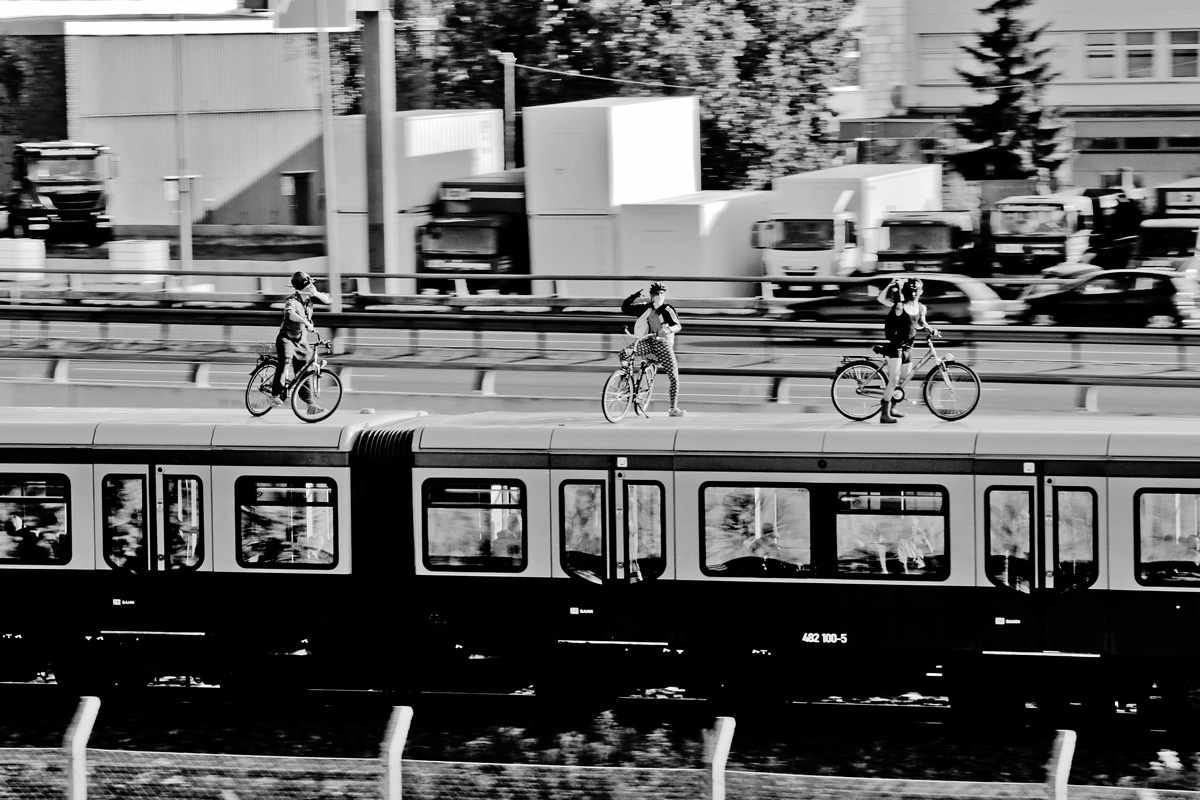
Thomas von Wittich – They See Me Rollin They Hatin
Open Walls: From your portraiture pieces to images of street artists in action, you demonstrate an impressive control over composition. How does someone develop such discipline and consistency?
Thomas: When I started photographing, my mentor told me two things – go close and look for lines. My background in music photography helped me as well – when you want to shoot a musician you usually wait for hours and then have 1 to 5 minutes to take your photos. I always used this waiting time to check the surroundings, looked for nice backgrounds or details and made some test shots. Now that I don’t have this waiting time anymore, I still prepare myself as good as possible. If that means that I have to climb a pointed roof with my tripod at a rainy night, then that’s that. Im willing to go quite far to get the shot I want.
Open Walls: Oddly enough, many of your works seem very impulsive despite the organized composition. How do you find so many artists willing to be shot while they are working?
Thomas: Most of the time I just ask politely. I am not just shooting random artists, I choose them very precisely. I always have a list in my head with up to ten artists I would like to work with. Sometimes I contact them immediately, sometimes I wait for the perfect occasion. It may be just one phone call or a friend knows a friend knows a friend and they just ask for me, or it may be that you have to put a little more effort. Lush for example was on my list for a long time but I didn’t saw myself going to Australia. When I saw that he was coming to Spain, I harassed him for a week or so with emails till he finally answered. He just asked for a wall to paint in Berlin, so I offered him one and it turned out that we worked together for one month with him staying at my place. Other times I was just lucky – Martha Cooper, for example, I just met by accident in the streets while both of us were working.
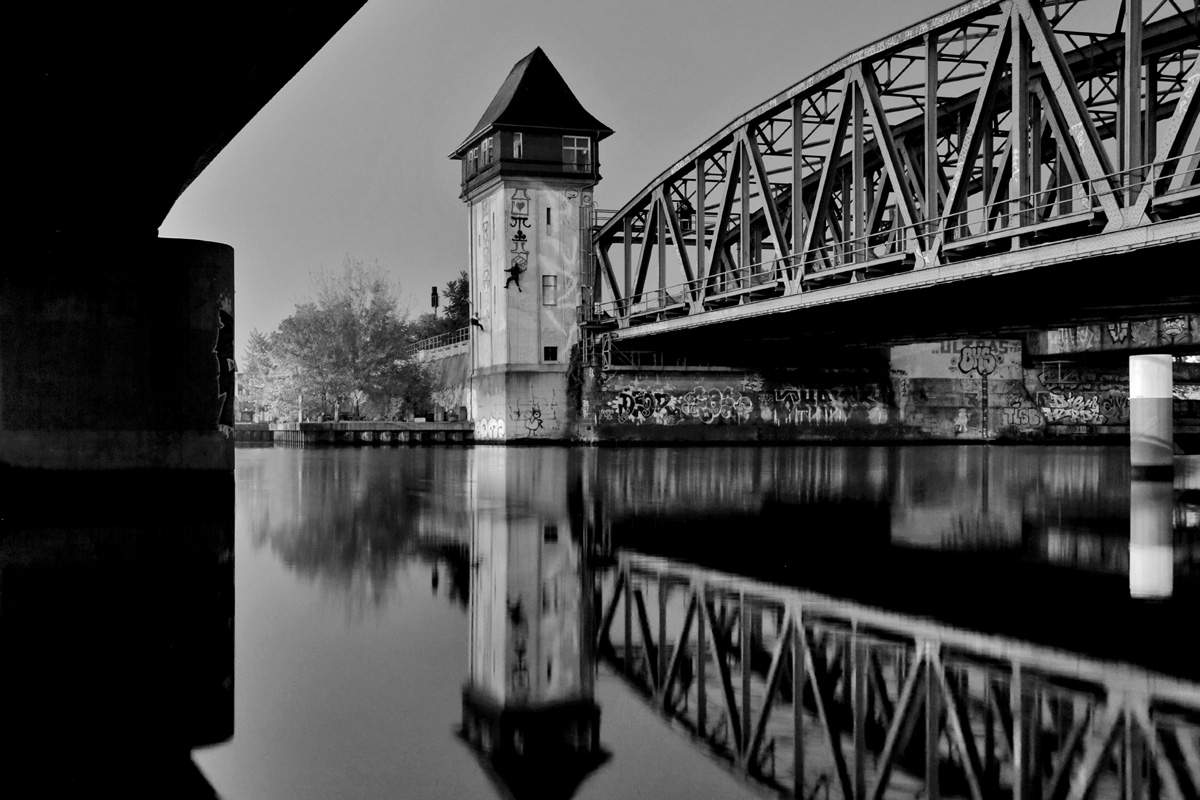
Thomas von Wittich – Untilted
Featured Inspirations, Goals and Future of van Wittich
Open Walls: What are the artists of the past or present that inspire you? Or are you perhaps more influenced by some style as a whole and not an individual?
Thomas: Jacob Aue Sobol, Anton Corbin, Robert Capa, Dennis Stock, Robert Doisneau, Kenneth Anger, Shinya Tsukamoto and the Marx Brothers
Open Walls: What is your ultimate goal as an artist? What fuels you from within and what is the message you are trying to send out to anyone viewing your work?
Thomas: Groucho Marx once said: I intend to live forever, or die trying. That is pretty much my goal as well. This and the certainty that I will be a one day a very entertaining grandfather with fun stories for my grandchildren. I want to make the people smile, cause surprise and show them things they usually wouldn’t see.
Open Walls: Now that you have the commodity to move around a bit, why choose to continue working in Berlin? Is there something special in the capital of Germany fitting for your artworks?
Thomas: I don’t know because I didn’t try to live in other places (except my small hometown) so far. Thats why I’m going to move to Paris in the end of the year.
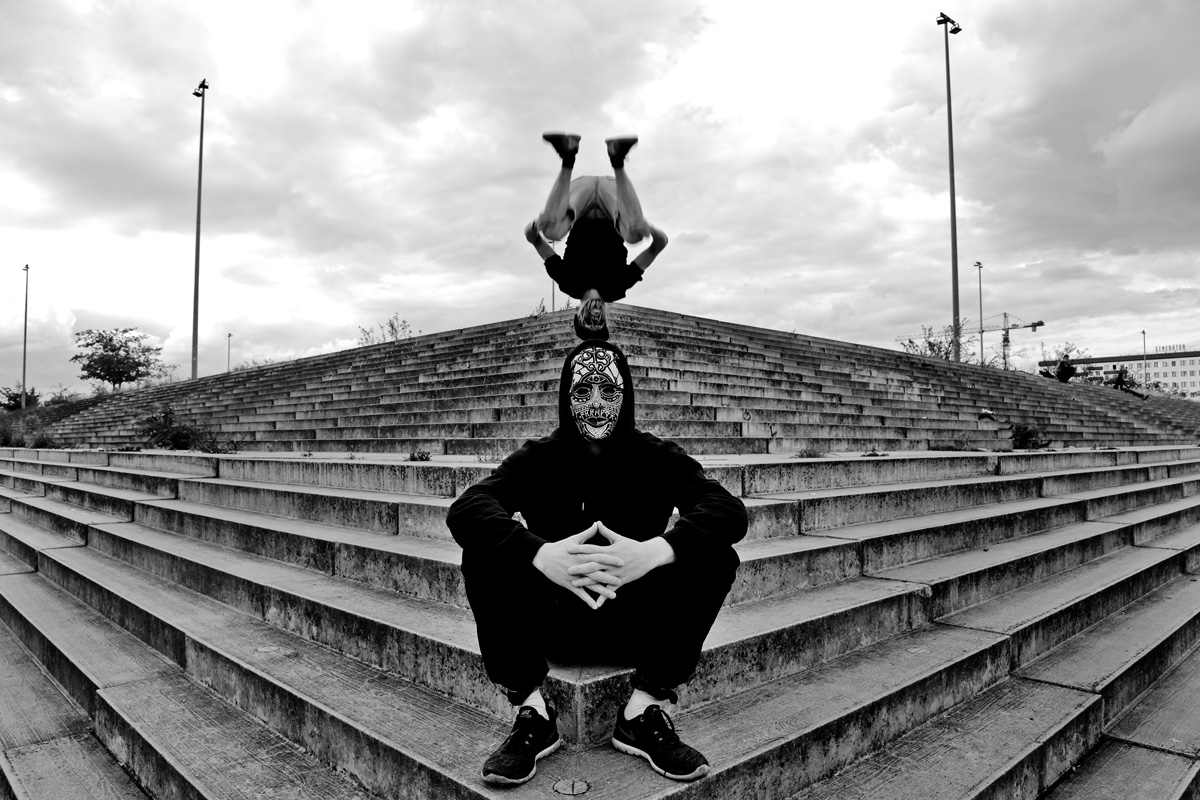
Thomas von Wittich – Untilted
Open Walls: Of all your previous projects, it seems that Berlin Kidz is the most action packed and adrenaline filled one. Was this, in your opinion, the most challenging project of your career so far?
Thomas: In terms of fitness it was for sure. Especially in the beginning when I was facing some situations where If you would have been telling me before that I will have to do that, I would have been saying no way. I can also remember a fun situation where we was checking a spot from where I wanted to shoot a train ride but there was a 2,5m high thin metal fence in front, spiky on top. They all were climbing over it like as if it was nothing and after desperately watching this for 2 minutes I decided that the 30 cm of free space under the fence will be enough for me to crawl under it. And the next night you find yourself on a roof of a house with 5 stages and the very urgent need to leave this place immediately without actually going back through the house and your body puts out a huge amount of adrenaline and somehow you are able to manage that. Now, after 2 years of following them with my camera, I became quite athletic and I got used to walking on roofs or climb a bit. I have to say that the Kidz were really taking care and never brought me in a situation I couldn’t handle.
Open Walls: What does the future have in store for you? Can we expect some new projects soon?
My plan for the next year is to bring my current exhibition to some other cities, to move to Paris and then slowly continue with a photo series I started some time ago but stopped it as I couldn’t put the attention it was asking when I was shooting with the Berlin Kidz. It’s too early to talk about that as I just started. I don’t really know yet in which direction it’s gonna bring me and it’s far away from my last projects, so I presume it will take me some time till I present that. But sure, I will continue to work in the urban art scene.
Written by Andreja Velimirović